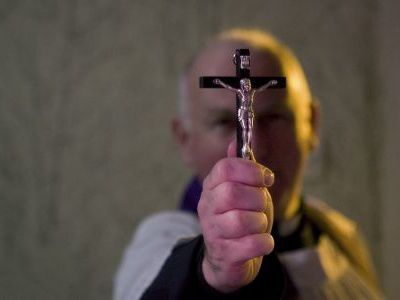The exorcists are exercising the bounds of belief. They are exercised by exorcisms.
At a weeklong conference on exorcisms in Rome last week, over 250 priests, theologians, psychologists and criminologists “rang the alarm on exploding demonic activity being fueled in part by access to the occult via the internet,” writes The Christian Post.
The Devil isn’t just in the details, he’s got wifi, and he’s online. He likely has a blog. He’s spreading porn, death and general hellfire across the wicked wide web, cackling as he types. He’s possessing people through Facebook and Instagram, known tools of Satan.
So, sure, perhaps thanks to the ubiquity of the internet, reports of demonic possession have mushroomed. In response, the Catholic Church is marshaling and grooming its troops to tackle the epidemic.

Hence the conference, as well as Pope Francis’s noted approval of the rococo rites, saying exorcists “manifest the Church’s love and acceptance of those who suffer because of the Devil’s works.”
Jesus — er, I mean damn. Because of the spike in requested exorcisms, “There are priests who carry out exorcisms on their mobile phones. That’s possible thanks to Jesus,” an Albanian Cardinal said at the conference, presumably with a straight face. (“That’s possible thanks to Jesus”? What about Verizon?)
Exorcisms on mobile phones? (Dial 666.) It’s hard to imagine. No crosses, rosaries or holy water? No comforting holding of hands and signs of the cross? No projectile pea-soup vomit? Do they use FaceTime, or just speaker phone?
Most of the aspiring exorcists truly and openly believe in a physical Devil, as does Pope Francis. They believe in full-blown possession of humans by evil spirits. They might actually believe the 1973 film “The Exorcist” is a documentary.
Demon-possessed people are known to suddenly develop supernatural strength, have radical changes in their voice and speak languages they’ve never known. They sound like superheroes.
“Most commonly they speak Latin, Hebrew and Aramaic,” says Father Pedro Barrajon. “If you show them a holy object, like a rosary or a cross or a picture of the Madonna, they go into shock and start yelling.”
That happens to me often, especially if it’s Madonna on her “True Blue” tour.

Figuring if actual demonic possession has occurred requires ruling out conditions like mental illness, epilepsy, schizophrenia, bipolar disorder or drug abuse.
“Not everyone who thinks they need an exorcism actually does need one,” said Bishop Thomas J. Paprocki. “It’s only used in those cases where the Devil is involved in an extraordinary sort of way in terms of actually being in possession of the person.”
I trip over that last phrase: actually being in possession of the person. Sometimes I feel satanically possessed, but it winds up being just a diabolical case of indigestion.
Yet these people, these hallowed priests and bishops (and pope!), honestly believe the Devil, that online prankster, can possess a human being and take over their mind and body, for whatever unfathomable purpose.

It’s no wonder that, even within the Church, stigma and cynicism wreathe the ceremony. It remains controversial, yet, as we’ve seen, exorcism’s popularity keeps swelling.
And the Church isn’t fooling around with that puckish Devil. The Albanian Cardinal said sometimes you had to get tough with him amid the magical theater of an exorcism and actually holler hurtful commands such as, “Shut up, Satan!”
There’s that, or you could call him a big ninny.
Flippancy aside, the truth is that the notion of exorcisms is so far removed from real, actual, everyday life, it simply does not make a single speck of difference, and, frankly, means absolutely nothing. It’s a sham, hysterical hocus-pocus, sheer knowing chicanery that does what it desperately needs to do: help keep a tottering Church from buckling.
